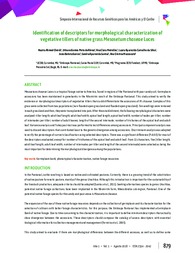Identification of descriptors for morphological characterization of vegetative tillers of native grass Mesosetum chaseae Luces.
Identification of descriptors for morphological characterization of vegetative tillers of native grass Mesosetum chaseae Luces.
Autoria: CHEICK, N. A.; ABREU, U. G. P. de; MEIRELLES, A. C.; SILVA, L. A. C. da; GARCIA, J. B.; SANTOS, S. A.; MAZZOCATO, A. C.
Resumo: Mesosetum chaseae Luces is a tropical forage native to America, found in regions of the Pantanal with poor sandy soil. Germplasm accessions has been maintained in genebanks in the Nhumirim ranch of the Embrapa Pantanal. This study aimed to verify the existence or morphological descriptors of vegetative tillers that could differentiate the accessions of M. chaseae. Samples of this grass were collected from two populations (non-flooded open grassland and flooded open grassland). Ten seedlings were removed in each grassland and then, they were transplanted into pots. After the establishment, the following morphological characters were analyzed: tiller length; adult leaf length; adult leaf width; apical leaf length; apical leaf width; number of nodes per tiller; number of internodes per tiller; number of adult leaves; length of the second internode; number of trichomes of the apical leaf and adult leaf. Variance analysis and Tukey post-test was performed to test differences among accessions. Principal component analysis was used to discard descriptors that contributed least to the genetic divergence among accessions. Discriminant analysis was adopted to verify the percentage of correct classification using selected descriptors. There was a significant difference (P<0.05) for most of the descriptors evaluated, except for number of trichomes of the apical leaf and adult leaf. From 11 characters, five (tiller length, adult leaf length, adult leaf width, number of internodes per tiller and length of the second internode) were selected as being the most important for determining the morphological divergence among the populations.
Ano de publicação: 2018
Tipo de publicação: Artigo em anais e proceedings
Unidade: Embrapa Pantanal
Palavras-chave: Banco de Germoplasma, Forage grasses, Germplasm conservation, Planta Forrageira
Observações
1 - Por padrão são exibidas publicações dos últimos 20 anos. Para encontrar publicações mais antigas, configure o filtro ano de publicação, colocando o ano a partir do qual você deseja encontrar publicações. O filtro está na coluna da esquerda na busca acima.
2 - Para ler algumas publicações da Embrapa (apenas as que estão em formato ePub), é necessário ter, no celular ou computador, um desses softwares gratuitos. Sistemas Android: Google Play Livros; IOS: iBooks; Windows e Linux: software Calibre.
Acesse outras publicações
Acesse a Base de Dados da Pesquisa Agropecuária (BDPA) para consultar o acervo completo das bibliotecas da Embrapa.

